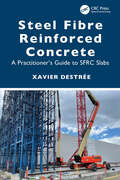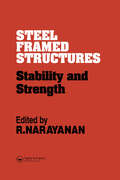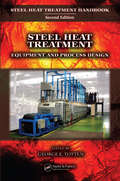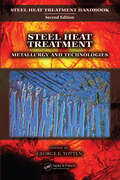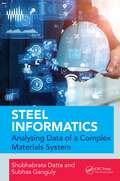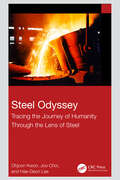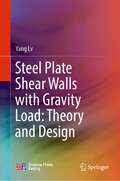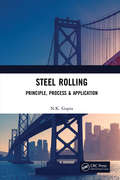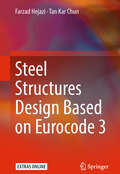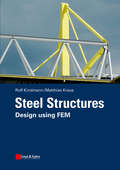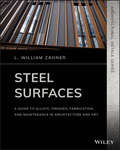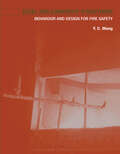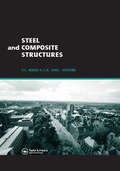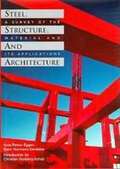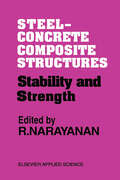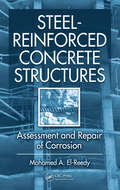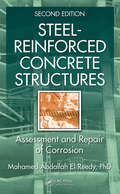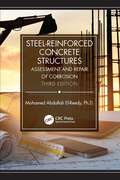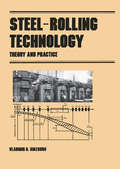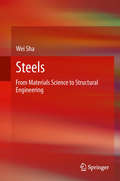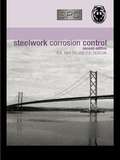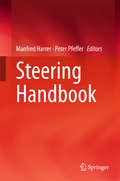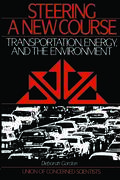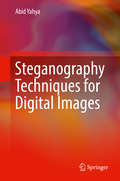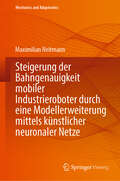- Table View
- List View
Steel Fibre Reinforced Concrete: A Practitioner’s Guide to SFRC Slabs
by Xavier DestréeSteel fiber reinforced concrete (SFRC) for structures dates back to 1925, yet it remains largely unknown to many engineers and contractors. Essential information is often buried in codes, reports, and standards. This book presents the essential information required by engineers to utilize SFRC effectively, achieving superior results across a range of applications.The focus is on its most common use in flat, horizontal cast in situ applications, such as ground-bearing slabs, ground-suspended slabs, suspended elevated slabs, and raft slab foundations for buildings, which present more opportunities than three-dimensional structures. Prefabrication and paving are discussed where they intersect with these main applications. Material and structural testing are addressed to guide the design for these typical applications, with attention also given to shrinkage, cracking, fire resistance of slabs and walls, and environmental benefits, alongside future opportunities and challenges. This unique book provides simple practical guidance for designing and placing SFRC It is especially helpful for design-and-build contractors and professional engineers It offers simple tools and methods to launch a project
Steel Framed Structures: Stability and strength
by R. NarayananSteel Framed Structures contains ten chapters on rigid frames, sway frames, multi-storey frames, interbraced columns and beams, elastic stability, moment-resisting connections, flexibly connected frames, portal frames, and braced arches.
Steel Heat Treatment: Equipment and Process Design
by George E. TottenOne of two self-contained volumes belonging to the newly revised Steel Heat Treatment Handbook, Second Edition, this book focuses on process design, equipment, and testing used in steel heat treatment. Steel Heat Treatment: Equipment and Process Design presents the classical perspectives that form the basis of heat treatment processes while
Steel Heat Treatment: Metallurgy and Technologies (Steel Heat Treatment Handbook, Second Edition)
by George E. TottenOne of two self-contained volumes belonging to the newly revised Steel Heat Treatment Handbook, Second Edition, this book examines the behavior and processes involved in modern steel heat treatment applications.Steel Heat Treatment: Metallurgy and Technologies presents the principles that form the basis of heat treatment processes while inc
Steel Informatics: Analysing Data of a Complex Materials System
by Shubhabrata Datta Subhas GangulySteel Informatics aims to review the application of data-driven computing techniques related to the design of steel, including phase transformation, composition-process-property correlation, and different processing techniques, particularly deformation and joining. This book initiates with fundamentals of informatics followed by a description of applications of statistical analyses in defining the different attributes of steel. The proceeding chapters of this book cover recent applications of statistical, machine learning, expert systems, and optimization algorithms in the domains of iron and steel making, casting, deformation, phase transformation and heat treatment, microstructure analysis, and design of steel.Features:• Exclusive title focussing on informatics in steel design.• Covers related statistics as well as artificial intelligence and machine learning aspects.• Explains metallurgical aspects lucidly for the data scientists, steel researchers, and industries.• Discusses all aspects of steel technology.• Describes pertinent tools used for related computations.This book is useful for researchers, professionals, and graduate students in metallurgy, materials science, steel and welding, and computational materials science.
Steel Odyssey: Tracing the Journey of Humanity Through the Lens of Steel
by Ohjoon KWON JOO Choi Hae-Geon LEEIn this wide-ranging interdisciplinary work, the authors draw on history, anthropology, and materials engineering to present a comprehensive and ambitious examination of the multifaceted roles of iron and steel throughout history and the current and future challenges faced by the steel industry.Ohjoon Kwon, Joo Choi, and Hae-Geon Lee provide readers with an in-depth understanding of the history of iron and steel and their impact on human society from a materials engineering perspective. They begin by describing the characteristics of iron and steel and the history of human use of and interaction with these metals by compiling the fundamental knowledge necessary to understand iron’s unique properties and metallurgical phenomena. Following this, they explain the influence of steel on human society and culture, focusing on Industrial Revolution and warfare. They also give examples that are rarely discussed elsewhere, such as developments in Asia or iron’s influence on thought and philosophy using Confucianism and Marxism as examples. Readers will then be able to apply this contextual knowledge to address the profound impact of emerging challenges, such as global environmental issues and the Fourth Industrial Revolution.Despite the technical nature of this book, all terminology is fully explained to facilitate better comprehension for those who may not possess an engineering education or a direct interest in metallurgy. This book is therefore invaluable not only as a technical book but also as a guide to the development history of human civilization and its future challenges.
Steel Plate Shear Walls with Gravity Load: Theory and Design
by Yang LvThis book is written by subject experts based on the recent research results in steel plate shear walls considering the gravity load effect. It establishes a vertical stress distribution of the walls under compression and in-plane bending load and an inclination angle of the tensile field strip. The stress throughout the inclined tensile strip, as we consider the effect of the vertical stress distribution, is determined using the von Mises yield criterion. The shear strength is calculated by integrating the shear stress along the width. The proposed theoretical model is verified by tests and numerical simulations. Researchers, scientists and engineers in the field of structural engineering can benefit from the book. As such, this book provides valuable knowledge, useful methods, and practical algorithms that can be considered in practical design of building structures adopting a steel shear wall system.
Steel Rolling: Principle, Process & Application
by N.K. GuptaThis book covers all aspects and elements of rolling technology in one volume with even the most technical jargon being communicated in an easy to understand language. The book is exhaustive as topics ranging from rolls, rolls cooling, roll turning, roll reclamation, investigation of roll breakage, roll management and roll bearing all have been dealt in detail as these constitute the most important element of production cost. A separate chapter has been dedicated to operational management of a rolling mill, which includes safety and inventory. Packaging of the finished products and modern operating mill practices and technologies are also discussed in detail. This book will be a useful tool for shop floor personnel and for all senior management operating in the rolling mill industry; it is also a must read for all polytechnic / engineering students of metallurgical / mechanical / process engineering.This book may also be useful as reference book for students/professionals of rolling technology. Note: T&F does not sell or distribute the Hardback in India, Pakistan, Nepal, Bhutan, Bangladesh and Sri Lanka.
Steel Structures Design Based on Eurocode 3
by Farzad Hejazi Tan Kar ChunThis book is tailored to the needs of structural engineers who are seeking to become familiar with the design of steel structures based on Eurocode 3. It explains each step of the design process using comprehensive flow charts, tables and equations as well as numerous examples. The useful appendices, including general sections and properties as well as general formulas for shear force, maximum bending moment and deflection for several selected loading conditions, offer designers a valuable source of reference. The book also introduces a specially developed design-aid program, which provides immediate results without the need for modeling, and as such considerably reduces the time needed for the design stage.
Steel Structures: Design using FEM
by Rolf Kindmann Matthias KrausThis book presents the design of steel structures using finite element methods (FEM) according to the current state of the art in Germany and the rest of Europe. After a short introduction on the basics of the design, this book illustrates the FEM with a focus on internal forces, displacements, critical loads and modal shapes. Next to finite element procedures for linear calculations considering the stress states of normal force, biaxial bending and warping torsion, non-linear calculations and the stability cases of flexural buckling, lateral torsional buckling and plate buckling are concentrated on significantly. In this context, design procedures for stability according to the standard Eurocode 3 is introduced and discussed. In addition, important fundamental issues are covered, such as the determination of cross-section properties as well as the elastic and plastic cross-section resistance. Complementary, finite element procedures for cross sections are dealt with, which will have an increasing importance in future. This book has evolved within the teaching activities of the authors in the lecture Computer-oriented Design of Steel Structures on the Master?s Program Computational Engineering at the University of Bochum. It covers the total variety of demands needed to be discussed for the safe, economic and modern design of steel structures.
Steel Surfaces: A Guide to Alloys, Finishes, Fabrication, and Maintenance in Architecture and Art (Architectural Metals Series)
by L. William ZahnerA full-color guide for architects and design professionals to the selection and application of steel Steel Surfaces, fourth in Zahner’s Architectural Metals Series, provides a comprehensive and authoritative treatment of steel applications in architecture and art. It offers architecture and design professionals the information they need to ensure proper maintenance and fabrication techniques through detailed information and full-color images. It covers everything from the history of the metal and choosing the right alloy, to detailed information on a variety of surface and chemical finishes and corrosion resistance. The book also features case studies that offer strategies for designing and executing successful projects using steel. Steel Surfaces is filled with illustrated case studies that present comprehensive coverage of how steel is used in creating surfaces for building exteriors, interiors, and art finishes. All the books in Zahner’s Architectural Metals Series offer in-depth coverage of today’s most commonly used metals in architecture and art. This visual guide: Features full-color images of a variety of steel finishes, colors, textures, and forms Includes case studies with performance data that feature strategies on how to design and execute successful projects using steel Offers methods to address corrosion, before and after it occurs Explains the significance of the different alloys and the forms available to the designer Discusses what to expect when using steel in various exposures Written for architecture professionals, metal fabricators and developers, architecture students, designers, and artists working with metals, Steel Surfaces offers a logical framework for the selection and application of steel in all aspects of architecture.
Steel and Composite Structures: Behaviour and Design for Fire Safety
by Y. C. WangSteel and Composite Structures: Behaviour and Design for Fire Safety presents a systematic and thorough description of the behaviour of steel and composite structures in fire, and shows how design methods are developed to quantify our understanding.Quantitative descriptions of fire behaviour, heat transfer in construction elements and structural an
Steel and Composite Structures: Proceedings of the Third International Conference on Steel and Composite Structures (ICSCS07), Manchester, UK, 30 July-1 August 2007 (Designer's Guides To The Eurocodes Ser.)
by Y.C. Wang and C.K. ChoiOver 150 papers representing the most recent international research findings on steel and composite structures. Including steel constructions; buckling and stability; codes; composite; control; fatigue and fracture; fire; impact; joints; maintenance; plates and shells; retrofitting; seismic; space structures; steel; structural analysis; structural components and assemblies; thin-walled structures; vibrations, and wind. A special session is dedicated on codification. A valuable source of information to researchers and practitioners in the field of steel and composite structures.
Steel, Structure and Architecture: A Survey of the Material and Its Applications
by Bjørn Normann Sandaker Arne Petter EggenNorwegians Eggen, an architect, and Sandaker, an engineer, sample some of the applications of steel in architecture, engineering, industrial design, and art during the 19th and 20th centuries, and discuss the material's properties, production methods, dimensioning, rust prevention and other surface treatments, joining methods, and combinations of steel with other materials such as wood and fabric. Highly illustrated with black-and-white photographs and drawings. Translated from Stal, Striktur og arkitektur, published by J. W. Cappelens, Forlag in 1995. Annotation c. by Book News, Inc. , Portland, Or.
Steel-Concrete Composite Structures
by R. NarayananThis is a collection of ten extensive review chapters by different authors.
Steel-Reinforced Concrete Structures: Assessment and Repair of Corrosion
by Mohamed El-ReedyA Practical Guide to Maintenance Carrying a billion-dollar price tag, corrosion of reinforced concrete is the enemy of every country's investment in real estate. The widespread and long-term use of reinforced concrete makes its correct and proper examination, maintenance, and repair paramount. Steel-Reinforced Concrete Structur
Steel-Reinforced Concrete Structures: Assessment and Repair of Corrosion, Second Edition
by Mohamed El-ReedyThis book examines the corrosion of reinforced concrete from a practical point of view, highlights protective design and repair procedures, and presents ongoing maintenance protocols. Updated throughout, this new edition adds additional information on concrete repair using Carbon Fiber Reinforced Polymers (CFRP), and reviews new examples of the effects of corrosion on both prestressed and reinforced concrete structures. It also examines economic analysis procedures and the probability of structural failures to define structural risk assessment, and covers precautions and recommendations for protecting reinforced concrete structures from corrosion based on the latest codes and specifications.
Steel-Reinforced Concrete Structures: Assessment and Repair of Corrosion, Third Edition
by Mohamed Abdallah El-ReedySteel-Reinforced Concrete Structures: Assessment and Repair of Corrosion, Third Edition examines the corrosion of reinforced concrete from a practical point of view, highlights protective design and repair procedures, and presents ongoing maintenance protocols. Updated throughout, this new edition adds additional information on concrete repair and reviews new examples of the effects of corrosion on both prestressed and reinforced concrete structures. It also examines economic analysis procedures and the probability of structural failures to define structural risk assessment and covers precautions and recommendations for protecting reinforced concrete structures from corrosion based on the latest codes and specifications. Features: Updated throughout and adds all new information on advanced testing and repair techniques Discusses the theoretical and practical methods of performing structural assessments Explains precautions for design and construction that reduce the risk of structural corrosion Covers traditional and advanced techniques for repair and how to choose the best methods Utilizes the newest building codes, specifications, and standards regarding construction and corrosion
Steel-Rolling Technology: Theory and Practice (ISSN)
by Vladimir B. Ginzburg"This state-of-the-art volume examines steel-rolling technology in a systematic and comprehensive manner--providing an excellent synthesis of current information from three different branches of science--physics, metallurgy, and engineering. "
Steels
by Na LiSteels and computer-based modelling are fast growing fields in materials science as well as structural engineering, demonstrated by the large amount of recent literature. Steels: From Materials Science to Structural Engineering combines steels research and model development, including the application of modelling techniques in steels. The latest research includes structural engineering modelling, and novel, prototype alloy steels such as heat-resistant steel, nitride-strengthened ferritic/martensitic steel and low nickel maraging steel. Researchers studying steels will find the topics vital to their work. Materials experts will be able to learn about steels used in structural engineering as well as modelling and apply this increasingly important technique in their steel materials research and development.
Steelwork Corrosion Control
by D.H. Deacon D.A. BaylissEngineers on major building projects continue to echo the sentiment that "painting amounts to 10% of the job, but provides 90% of the problems". This second edition of Steelwork Corrosion Control provides sound advice and authoritative guidance on the principles involved and methods of achieving sound steel protection. Taking into account the consi
Steering Handbook
by Manfred Harrer Peter PfefferThis edited volume presents basic principles as well as advanced concepts of the computational modeling of steering systems. Moreover, the book includes the components and functionalities of modern steering system, which are presented comprehensively and in a practical way. The book is written by more than 15 leading experts from the automotive industry and its components suppliers. The target audience primarily comprises practicing engineers, developers, researchers as well as graduate students who want to specialize in this field.
Steering a New Course: Transportation, Energy, and the Environment
by Warren Leon Deborah GordonSteering a New Course offers a comprehensive survey and analysis of America's transportation system -- how it contributes to our environmental problems and how we could make it safer, more efficient, and less costly.
Steganography Techniques for Digital Images
by Abid YahyaThis book covers newly developed and novel Steganography techniques and algorithms. The book outlines techniques to provide security to a variety of applications using Steganography, with the goal of both hindering an adversary from decoding a hidden message, and also preventing an adversary from suspecting the existence of covert communications. The book looks into applying these newly designed and improved algorithms to provide a new and efficient Steganographic system, called Characteristic Region-Based Image Steganography (CR-BIS). The algorithms combine both the robustness of the Speeded-Up Robust Features technique (SURF) and Discrete Wavelet Transform (DWT) to achieve characteristic region Steganography synchronization. The book also touches on how to avoid hiding data in the whole image by dynamically selecting characteristic regions for the process of embedding. Applies and discusses innovative techniques for hiding text in a digital image file or even using it as a key to the encryption;Provides a variety of methods to achieve characteristic region Steganography synchronization;Shows how Steganography improves upon cryptography by using obscurity features.
Steigerung der Bahngenauigkeit mobiler Industrieroboter durch eine Modellerweiterung mittels künstlicher neuronaler Netze (Mechanics and Adaptronics)
by Maximilian NeitmannMobile Roboter besitzen das Potenzial, zu deutlichen Effizienzsteigerungen in der Fertigung kohlenstofffaserverstärkter Kunststoffe zu führen, wenn sie die aktuell üblichen Sondermaschinen ersetzen. Dazu müssen die mobilen Roboter Bahngenauigkeiten im Submillimeterbereich erreichen. Da stationäre Roboter diese Bahngenauigkeiten mit Modellerweiterungen erreichen können, ist es die Kernfrage dieser Arbeit, ob diese auf mobile Roboter übertragbar sind. Bahngenauigkeitsuntersuchungen zeigen, dass sich die mobile Plattform in erster Linie durch eine herabgesetzte Fundamentsteifigkeit auswirkt. Weiterhin wird beobachtet, dass die Trägheitskräfte des Roboterarmes genügen können, um eine Bewegung der Plattform relativ zum Hallenboden zu erzeugen. Die Arbeit zeigt, dass künstliche neuronale Netze in der Lage sind, den Bahnfehler des mobilen Roboters mit einer mittleren Abweichung zum gemessenen Bahnfehler von 0,3mm vorhersagen zu können und damit potentiell dazu geeignet sind, die Bahngenauigkeit eines mobilen Roboters in den Submillimeterbereich zu steigern. Durch den Austausch des Bahninterpolators zwischen der Aufnahme der Trainingsdaten und der Erprobung der Modellerweiterung kann die Arbeit keine Genauigkeitssteigerungen zeigen. Mit einer Erweiterung des Trainingsdatensatzes oder durch den Einsatz nur eines einzigen Bahninterpolators scheint es jedoch möglich zu sein, dass Folgearbeiten die Steigerung der Bahngenauigkeit in den Submillimeterbereich nachweisen können.
